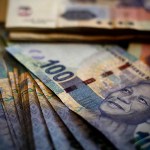Neil Phillips, the co-founder and chief investment officer of a UK-based hedge fund, was charged by US prosecutors for conspiring to rig trades involving the US dollar-South African rand currency pair to ultimately trigger a payout to his firm worth $20-million.
At the request of the US Department of Justice earlier this week, 52-year-old Phillips was arrested in Spain and charged with conspiring to manipulate the dollar-rand exchange rate in December 2017, according to a statement issued by the department on Thursday, 1 September.
Phillips’s investment firm wasn’t identified in the statement but Bloomberg reported that it is named Glen Point Capital, a macro hedge fund firm that pools the funds of investors (usually wealthy ones) to invest in a range of asset classes, including currencies.
Phillips’s only link to South Africa is that he executed currency trades of the local rand while he was in the country on 26 December, also known as Boxing Day. But in executing trades in the dollar-rand exchange rate, he “engaged in a scheme to intentionally and artificially manipulate” currency markets.
Through his UK-based hedge fund firm, Phillips bought what is known as “options” for the dollar-rand exchange rate in late October 2017. Options are investment products, which involve investors betting on currency exchange levels. Investors usually select a level at which the currency would trade at a particular date — known as a target price. And through normal and unmanipulated currency movements, traders or investors can make money if the dollar-rand exchange rate hits the target price at a particular date.
In Phillips’s case, he purchased options worth $20-million in late October 2017, which were set to expire on 2 January 2018. Before this expiration date, the dollar-rand exchange rate, through normal market forces, had to go below R12,50 (the target price set by Phillips) for him to get back the initial investment worth $20-million and book profits.
Early acts of rigging the rand
By 26 December 2017 — seven days before the expiration date on his option contract — Phillips realised that the dollar-rand exchange rate was not going below the R12,50 target price, which would put his $20-million at risk.
On a normal day, there is a hive of activity in the currency market, with traders executing rand-dollar currency pair trades worth about $51-billion every day. But December is usually a quiet month for financial markets because traders are usually on their Christmas holiday and there are thin trading volumes in currency markets.
And December 2017 was important for South Africa as it was the month in which Cyril Ramaphosa was elected — through an internal political party election — as ANC president. Currency markets were optimistic about a Ramaphosa ANC win, and no bad news could create volatility or weakness in currency markets, particularly the rand-dollar currency pair.
Assuming that, Phillips panicked, he launched a scheme on 26 December 2017 to “artificially” drive the dollar-rand exchange rate below R12,50.
In doing so, Phillips, who was in South Africa at the time, began making trades to push the exchange rate lower. He directed a Singapore-based employee of an unidentified bank — using a Bloomberg chat room — to sell $725-million (US dollars) in exchange for more than R9-million (South African rand), according to US prosecutors. In other words, Phillips sold dollars to receive rands, through his hedge fund.
Instability in financial markets
Such a large volume of money moved through the local currency movement in late December 2017, at a time when most currency traders took their working caps off and hit the beach. Traders would allow market forces to normally influence the rand and not execute large trades that cause big shifts in the local currency market.
Phillps was successful because, through his trades, the rand fell below R12,50 (reaching Phillps’s target price). This enabled Phillips to collect more than $15.6-million from the deal, according to the statement, covering his initial $20-million investments and some profits. In the words of US prosecutors, the “pernicious” actions of Phillips paved the way for him to “receive a wire transfer of $15,660,000 and… a wire transfer of $4,340,000”.
Authorities around the world, including South Africa’s Competition Commission, are clamping down on the operations of currency traders of financial institutions, and are accused of rigging currency trades.
It’s hard for a few currency traders to cause big shifts in the exchange rate movements against the US dollar. Currency trading (beyond trades in the dollar-rand exchange rate) is a large market — with more than $6-trillion traded daily, making it almost impossible to cause big shifts in an exchange rate, even with a coordinated strategy to rig currency markets by traders.
The rand-dollar currency pair, specifically, trades about $ 50-billion every day, and the actions of one currency trader are unlikely to lead to large or long-term shifts in the rand’s value. Rather, traders of currencies at a bank level would feel the pain of slight movements in the exchange rate — influenced by the likes of Phillips and other rogue traders. Banks help customers exchange currencies of various countries. Slight movements in the dollar-rand exchange rate would allow banks to grow the “spread”, which is the gap between the “bid” (the price banks buy any currency at) and the “offer” (the price at which they sell currencies). A bank usually sits between people or clients that usually need to convert dollars into rands and vice-versa.
For example, South Africa-based mining houses usually need to convert dollar-based commodities they produce into rands during the sales process of such commodities. Mining houses usually approach banks for this function. A bank currency trader might offer to buy dollars from the mining house at R17,205 per dollar. But this would usually be at an inflated price (following the currency rigging scenarios) as normal market forces would pitch the rand at R17,105 per dollar. The difference between the two the pricing (nearly one cent) could run into thousands or millions of dollars for the mining house. DM/BM




















Mining companies must be laughing all the way to the bank with high commodity prices and the Dollar/Rand exchange rate of over R17 to $1. My business involves supplying mining companies and getting paid in dollars is a definite bonus. All the action seems to be happening in central and west Africa. Nothing seems to be happening in South Africa regarding investment in new mines. Is it red tape, power problems or corruption. My guess it’s all 3.